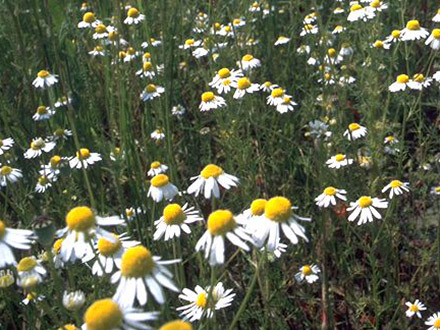Botanical name
(True) Chamomile - Matricaria recutita L.
Family
Aster or Composite family (Asteraceae or Compositae)
Common name
German chamomile, Field chamomile
Information about the plant
Chamomile is native to Southern and Eastern Europe and the Middle East, but it has now spread throughout Europe, North America and Australia. It is cultivated in Bulgaria, Hungary, Egypt and Argentina, and only to a very limited extent in Germany and Spain. The genus name come from the Latin "matrix" (= uterus; genitive form = matricis) and indicates that the plant has traditional medicinal uses in women's gynaecological complaints. Chamomile grows 20 to 40cm tall with 2 to 3 fold pinnate leaves with long, fine leaflets. The flower heads consist of tubular yellow flowers, which grow on a curved conical receptacle, surrounded by about 15 white ray florets. Whether it really is the True Chamomile can be seen in a longitudinal section through the flower: the flower base must be hollow. Chamomile likes to grow on the sides of roads and fields and blossoms from May to September.
Medicinally used parts of plants (herbal drug)
The flowers are used with their typical chamomile scent, which is created by the essential oil it contains. It is in the glandular scales on the surface of the flower and it is released when you rub them. The commercially available drug comes from imports from Hungary, Argentina and Egypt.
Constituents of the herbal drug
Chamomile flowers contain essential oil ("Chamomile oil") and sesquiterpenes (bisabolol, bisabolol oxide) and enyne Dicycloethern. The essential oil is an intense blue colour because of the blue-coloured, volatile chamazulene produced from the nonvolatile Matrizin during the water steam distillation. In addition, it also contains flavonoids, phenolic acids and gums.
Quality of the drug
The quality of the following drugs or drug preparations is specified in the European Pharmacopoeia (Ph. Eur.):
- Chamomile Flowers (Matricaria flos)
- Chamomile fluid extract (Matricariae extractum fluidum)
- Chamomile oil (Matricariae aetheroleum)
Medical applications
Recognised medical use
Externally (Commission E, ESCOP)
- Bacterial skin diseases, including the mouth and gums
- For wound treatment: for superficial skin lesions, leg ulcers, pressure ulcers, burns, surgical wounds, radiation damage, sunburn, frostbite.
- Diseases in the anal and genital area (baths, douches)
- Respiratory infections and irritations of the respiratory tract (inhalation)
- Cramps in the stomach-intestinal tract
- Inflammatory diseases of the gastrointestinal tract (e.g. stomach ulcers and gastritis)
Traditional use
Traditionally used to support the gastrointestinal function and to improve the condition of stomach discomforts, improving the function of the skin, improving the function of the mucous membranes in the mouth and throat (traditional application acc. to § 109a).
Herbal drug preparations in finished dosage forms
- Chamomile as a tea, in teabags
- Alcoholic extracts and liquid extract drops for ingestion
- Dried extracts in pills
- Alcoholic extracts in creams, ointments, mouth creams and baths for external use
- Chamomile oil in ointments, baths and solutions for external use
- Chamomile tincture in liquid preparations
Dosage
Prepared drugs: see package insert;
Tea infusion: drink 1 cup freshly prepared hot chamomile tea 3 to 4 times a day between meals. The tea can also be used for a mouthwash or to gargle. As a bath additive use 50g chamomile flowers for every 10 litres of water. For inhalation, put a handful of chamomile flowers or a few drops of chamomile oil in hot water.
Preparation of a tea
Pour 150ml of hot (not boiling!) water over 1 tablespoon of chamomile flowers (approx. 3g) 5 - let it stand for 10 minutes and then strain.
Notes
Chamomile preparations must be avoided with existing allergies to Compositae (Asteraceae).
Side effects
Rarely allergies
Interactions
None known
References
Herbal drug monographs
Commission E, ESCOP, WHO Vol. 1
Further literature
Wichtl: Teedrogen und Phytopharmaka, pg. 420
Schilcher: Leitfaden Phytotherapie, pg. 139
Van Wyk: Handbuch der Arzneipflanzen, pg. 200
Kommentar zum Europäischen Arzneibuch (Chamomile flowers, no. 0404; Chamomile fluid extract, no. 1544; Chamomile oil, no. 1836)


